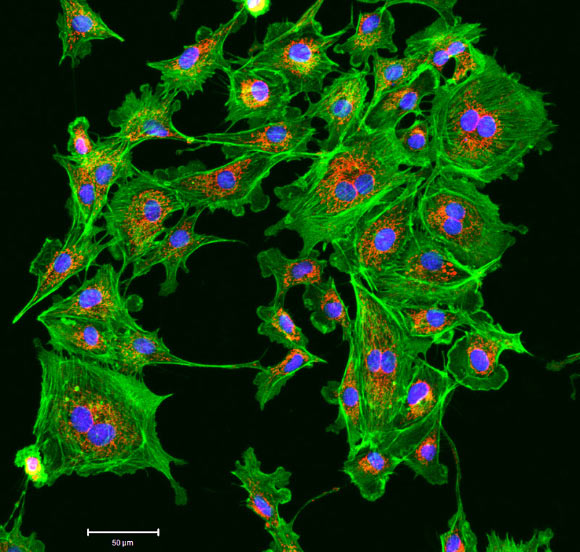According to two studies published in the journal Stem Cells and the journal Developmental Cell (full paper), damaged or diseased human organs may someday be healed with an injection of engineered endothelial cells, the cells that make up the structure of blood vessels.

This fluorescence image shows endothelial cells. Image credit: Kandasamy, Biomedical Microscopy Core, Paul D. Coverdell Center.
Lead investigator Prof Shahin Rafii from Weill Cornell Medical College and Ansary Stem Cell Institute, and his colleagues show that endothelial cells are powerful biological machines that drive regeneration in organ tissues by releasing beneficial, organ-specific molecules.
They discovered this by decoding the entirety of active genes in endothelial cells, revealing hundreds of known genes that had never been associated with these cells.
They also found that organs dictate the structure and function of their own blood vessels, including the repair molecules they secrete.
“Together, the studies show that endothelial cells and the organs they are transplanted into work together to repair damage and restore function. When an organ is injured, its blood vessels may not be able to repair the damage on their own because they may themselves be harmed or inflamed.”
“Our work suggests that that an infusion of engineered endothelial cells could engraft into injured tissue and acquire the capacity to repair the organ,” Prof Rafii said.
“These studies – along with the first molecular atlas of organ-specific blood vessel cells reported in the Developmental Cell paper – will open up a whole new chapter in translational vascular medicine and will have major therapeutic application.”
“Scientists had thought blood vessels in each organ are the same, that they exist to deliver oxygen and nutrients. But they are very different, and each organ is endowed with blood vessels with unique shape and function and delegated with the difficult task of complying with the metabolic demands of that organ.”
In the Developmental Cell study, the scientists examined nine different tissues at homeostasis as well as liver and bone marrow recovering from a traumatic injury. They developed technology that helped them obtain a pure population of endothelial cells in a very rapid time frame. From these cells, they were able to take a snapshot of all the genes that are being expressed in the various populations of endothelial cells known as vascular beds.
They found that endothelial cells possess tissue-specific genes that code for unique growth factors, adhesion molecules, and factors regulating metabolism.
“We knew that these gene products were critical to the health of a particular tissue, but before our study it was not appreciated that these factors originate in the endothelial cells,” said Dr Daniel Nolan of Weill Cornell Medical College, first author of the Developmental Cell study and co-author of the study published in the Stem Cells.
The findings raise the question as to how endothelial cells have the capacity to adapt to the biological demands of each organ. Is it possible to design immature endothelial cells that could allow scientists to identify the means by which the microenvironmental cues educate them to become more specialized endothelial cells?
To address this issue, the team postulated that endothelial cells derived from embryonic stem cells could behave as resilient endothelial cells, being able to be taught how to act like an organ-specific blood vessel. Indeed, in the Stem Cells study, the scientists generated endothelial cells from mouse embryonic stem cells that were functional, transplantable and responsive to microenvironmental signals.
These embryonic-derived endothelial cells are versatile, so they can be transplanted into different tissues, become educated by the tissue, and acquire the characteristics of the native endothelial cells. Researchers can propagate these cells in large numbers in the laboratory.
“We now know what it takes to keep these cells healthy, stable and viable for transplantation,” said Dr Sina Rabbany of Weill Cornell Medical College, who is a senior author of the Stem Cells study.
“Additional preclinical investigation is required before study of endothelial cell transplantation in humans is possible, but the therapeutic potential of endothelial cell transplantation is endless. They could also be used as Trojan horses to block tumor growth, they could be altered to carry toxic chemicals. They could become biological cruise missiles, directed to do many things inside diseased organs. Our work has just begun,” Dr Rafii concluded.
______
Bibliographic information: Edo Israely et al. 2013. Akt suppression of TGFβ signaling contributes to the maintenance of vascular identity in embryonic stem cell-derived endothelial cells. Stem Cells, published online; doi: 10.1002/stem.1521
Daniel J. Nolan et al. 2013. Molecular Signatures of Tissue-Specific Microvascular Endothelial Cell Heterogeneity in Organ Maintenance and Regeneration. Developmental Cell, vol. 26, no. 2, pp. 204-219; doi: 10.1016/j.devcel.2013.06.017







